Since the early 1990s, a family of producers and artists with a background in Nashville recording has somewhat haphazardly developed an aesthetic which signifies “acousticness,” “authenticity,” and “hipness.” These various musical strands and recording practices reached their apex with the release of the film soundtrack, O Brother, Where Art Thou?, a work whose particular approach to recorded musical sound has become codified into what I refer to as the O Brotheraesthetic.
As a secondary market, country music has historically followed trends rather than set them.1 And so the commercial dominance of the O Brother soundtrack has left many music makers from both sides of the great pop/country divide, including a number of artists on the O Brother album and related tours, in a sonic quandary. After these musicians have spent entire careers trying to catch the “last big thing” in the recording studios, this one-off soundtrack album—a momentary diversion for most of the participants—has emerged as the “next big thing” in pop music production. How this sonic aesthetic was arrived at, and why so many of the releases by musicians who appear on the soundtrack diverge from this aesthetic, is the subject of this article.
The first bluegrass revival of the late 1950s was kick-started by young musicians with little technological savvy. By the time of the second revival in the early 70s, a generation of musicians had educated themselves in the art of sound recording. The sonic aesthetics of this younger generation of performers and audiences were as much informed by the flowering of British art-rock as by any Lomax field recording. Employing multitrack technology, musicians recorded in severe isolation from one another, or even over-dubbed one part at a time. Individual instruments were afforded their own microphone (or in many cases, several microphones) as well as their own tracks on tape. Such isolation offered a far greater degree of sonic clarity, but also required the musicians and engineers to re-create a simulacrum of musical environment and exchange (Toynbee 89–93). Often, musicians were not playing together in the same room, though the finished recordings strove to sound like they had.2
Throughout the 70s, Nashville recording engineers and producers slowly mastered the practice of multitracked musical isolation. By the early 1980s, many of the third generation revivalists had grown tired of the sound of mainstream country imitation pop, and looked elsewhere for sonic inspiration. They found it in the phenomenal success of New Age, epitomized by the Windham Hill label in albums such as Michael Hedges’s Aerial Boundaries.3 Minimal instrumentation recorded with close-miked clarity, then “tastefully” obscured with abundant digital reverb, like a Vaseline smeared close-up of Greta Garbo, New Age music became enormously popular with the emergent Yuppie social class, perhaps the earliest indication of the superaltern4 alternative market now being targeted by the neo-new traditionalists. Given the intense focus on the sound of individual instruments, it is not surprising that a number of young bluegrass revivalists, such as Mark O’Connor and Jerry Douglas (with Strength in Numbers), as well as other folk instrumentalists like Leo Kottke, have embraced this sonic aesthetic. Consequently, as they have lent their talents in support of singers like Dolly Parton and Alison Krauss, so have their approaches to recording become integrated into the aesthetic of their vocalist employers.
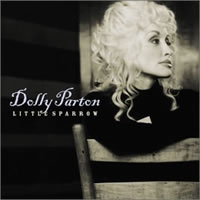
Though not an O Brother participant, Dolly Parton’s recent recordings clearly benefit from an association with an “acoustic” aesthetic, and differ greatly from most of her prior recording career which followed the trends of pop music production, though characteristically a few years out of step. Her “acoustic bluegrass” trilogy (The Grass is Blue, 1999; Little Sparrow, 2001; Halos and Horns, 2002) is as far from acoustic as it is from bluegrass, and stands as a vivid demonstration of the paradox surrounding much of the neo-new traditionalist sonic aesthetic. Though a good deal of the instrumental interplay is performed and recorded in real time, many of Parton’s vocal contributions, as well as a number of other elements were clearly overdubbed. The aesthetic at play here involves both a simulacrum of a singular performance made by a group of individuals in real time, as well as the sometimes intentional, though always obvious layers of disembodied performances, considered artistic production “touches.” The sounds of guitars, fiddle and banjo are abruptly joined by ethereal choirs, evincing a “Where did that come from?” response in the listener, as in “Down From Dover” from Little Sparrow.
Parton’s acoustic trilogy has been touted as a return to her east Tennessee mountain roots, and in comparison to her recordings of the 1980s and 90s, they are remarkably different. But Parton is not simply a Tennessee mountain girl, she is an oversized cultural icon—Dolly. As she claims to wear make-up and wigs even when not in the public eye, such surface decorations are at her very core identity. It would be un-Dolly-like to remove the layered choirs and echoing dobro licks from her music. She may be wearing (designer) denim, but her make-up artists and hair stylists are still working overtime, and as such, her recent recording endeavors stand apart from similar offerings by her contemporaries, with one notable exception.
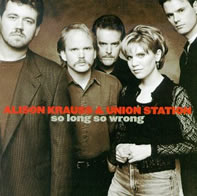
The recordings of Alison Krauss most certainly stood as a template for the Dolly Parton trilogy, both in terms of instrumental and vocal arrangements, as well as sonic presentation. Gary Pacsoza, who also has engineered many of Krauss’s recordings, recorded Parton’s first two acoustic albums, and his recording approach (clear instrumental separation, an accentuation of the higher frequency spectrum, and a penchant for prominent reverbs) establish a direct link between the two artists. Krauss’s rise from the bluegrass festival circuit to TNN video star in the mid-90s was an early indication that acoustic folk music could find a place in the contemporary country music scene.
Krauss chose songs from outside the traditional old time and bluegrass repertoire, often looking to songwriters from the contemporary folk scene for material and for sonic models.5 As Suzanne Vega and Tracy Chapman emerged from the coffeehouses with expensive, pristine productions, a new commercial friendly recording aesthetic was formed. Keeping the chiming acoustic guitars and breathy vocals couched in shimmering reverbs while replacing the electric guitars and synthesizers found in the Vega and Chapman records with fiddles, dobros, and banjos, Krauss constructed a winning formula that propelled her from the lower commercial echelons of the bluegrass circuit to the top of the contemporary country charts with songs such as “So Long, So Wrong.” The contrast between Krauss and her rhinestone cowboy neighbors on the airwaves singled her out as an “authentic” musician carrying on in the tradition of Bill Monroe, though the sonic qualities of her recordings had more to do with upscale coffee than downhome “white lightning.”
As with many of her contemporaries, Emmylou Harris has chased the trends of popular music, as the numerous sonic shifts reflected in her recording career attest. However, rather than cast her eye towards the top of the Billboard charts, she aspires to the five star Rolling Stone review. This divergence from the commercial aspirations of mainstream country music has always set Harris apart from most of her Nashville contemporaries.
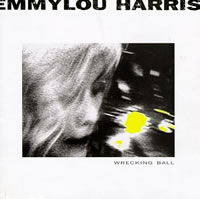
Harris’s most dramatic embrace of the pop/rock aesthetic was her collaboration with producer Daniel Lanois on 1995’s Wrecking Ball. Lanois’s previous work with U2, Peter Gabriel, The Neville Brothers, and Bob Dylan defined one sonic aesthetic—the sound of a band playing together in the same physical space, then drenched in dense, atmospheric textures created by multiple digital reverbs and effects—a kind of psychedelic Americana, as in Harris’s cover of Gillian Welch’s “Orphan Girl.” Not since Phil Spector had a producer so completely stamped an individual sonic imprint on his work with/for other artists (Eisenberg 125–128).
The Wrecking Ball experiment was Harris’s most decisive break from traditional Nashville musical aesthetics, and at first sounds almost like a photographic negative to the O Brother soundtrack. But what both projects share is a reconsideration of the recording process. With a greater emphasis placed on capturing the interaction between musicians at one point in time, as opposed to the laborious assemblage of overdubbed performances, Wrecking Ball employed the same methods used to record country music in the decades prior to the 1960s. As an approach to process rather than a sonic aesthetic, it can be seen as a template for the back-to-basics approach of O Brother.
One of the signature tracks from Wrecking Ball was Gillian Welch’s “Orphan Girl,” and Harris’s treatment was the first mainstream exposure given to Welch’s work. Welch’s first two albums, Revival and Hell Among The Yearlings, demonstrate Welch’s fully formed “voice” as a songwriter, but reflect an unfocused sonic aesthetic. Producer T-Bone Burnett, drawing on his past work with Elvis Costello, Los Lobos, and Sam Philips, casts about for individual sonic vehicles for Welch’s material. From Lanois-type distortion and delays on “Orphan Girl,” to the Patsy Cline-esque “Paper Wings,” or the strikingly effect-free intimacy of “Acony Bell” and “By The Mark,” Welch’s first two albums represent a search for a new sonic aesthetic, but not its realization.
Her third album, Time (The Revelator), is the culmination of the search, and serves as the template for the post O Brother sound. Time was a self-financed, -produced, and -released album, and Welch and her partner David Rawlings minimized their time spent in the studio by avoiding overdubs and extended, complex mixes. Live performances captured with top-of-the-line microphones and preamps resulted in a low budget/high fidelity recording.
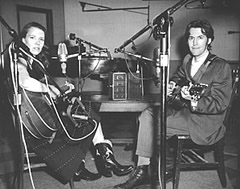
With Rawlings seated directly across from Welch, a simple set-up of one microphone for each instrument and voice, unadorned by reverbs and delays (as in “Dear Someone”) provides a sonic consistency throughout the record.6 But more importantly, such direct, eye-to-eye contact captures the process of music making among musicians, and by minimizing the separation of isolation booths and headphones, the microphone is transformed from distancing mediator to gathering focal point. The microphone establishes “place,” and encourages musical participation and interaction. Performance becomes directed towards fellow musicians, and the listening audience becomes privileged voyeurs. This performance of process became the defining aesthetic of both the O Brothersoundtrack and its successive tour, captured in the documentary, Down From The Mountain.
Down From The Mountain, filmed at a concert in the Ryman Auditorium a month before the premiere of O Brother, Where Art Thou?, provides a visual manifestation of the O Brother sonic aesthetic. Directly emulating scenes from O Brother when the main characters gather around a single microphone at a radio station, and later on a grange hall stage, the vocalists from the soundtrack gather around a microphone at center stage, supporting musicians encircle solitary microphones at stage right and left.7
This arrangement accomplishes two things—the musicians must control their own balances to one another while performing with and to each other, replicating the process aesthetic, and codifying the process as a consciously attained “authenticity” for the benefit of the audience. Most live music performance employs individual microphones or other amplification for each instrument and each voice, rendering the stage a complex obstacle course of cables and stands. The Down From The Mountain show draws attention to the cleanliness of the stage sightlines, most especially to the sound monitors concealed in the stage apron, completely out of audience (and camera) view. The theatricality of this set up calls attention to the limited technology being visibly employed, and in many ways the audience is more aware of these very few microphones, and of sound reinforcement in general, than if they were witnessing the latest high-tech rock show.
Microphone technology is reconciled with the “acoustic” musical tradition by designating specific microphones as “authentic.” A recent issue of Mix, an industry journal marketed to recording engineers and producers, was devoted to Nashville and “that old-time sound.” In it, an article on the Down From The Mountain show notes, “there was also nary a modern condenser mic in sight; rather the stage was dominated by vintage Neumann U47s, mics not usually used in concert applications, but which had the appropriate look for the concert and film” (Jackson 22).
That a certain microphone should have an appropriate “look” begs the question, who is the look appropriate to? Is there a presumption that the audience can identify the Neumann U47, and is familiar with its history? Or is the “look” more important to the musicians behind the microphone. Either way, the deification of the U47 as “appropriate” to music meant to evoke 1930s Great Depression America is an “invented tradition” in that great line of invented traditions documented by Eric Hobsbawm, Robert Cantwell, Regina Bendix, and so many others; the Neumann company of Berlin, Germany only began manufacturing the U47 in 1947.8
The first test of the post-O Brother marketplace, T-Bone Burnett’s production of Ralph Stanley, fails to achieve the effect of the new sonic aesthetic, and is instead an example of processing used to salvage a faulty process. “O Death,” Stanley’s stand out performance from the soundtrack was an a cappella performance, and it is the a cappella performances on Ralph Stanley that are the most rewarding. The songs that feature Burnett’s A-List bluegrass studio band work only intermittently; the success of each recording is in inverse proportion to the number of instruments employed in the arrangements.
Part of the problem lies in the difficult task of recording and balancing Stanley’s singing voice with the more delicate sounds produced by guitars and mandolins. The nasal cavity-induced partials and transients that could wreak havoc with recording levels are brought under control with the aid of compression, liberally used. Compression, used in many stages of recording to keep levels from distorting, can also be used to keep several high-amplitude producing signals (such as drums and electric guitars) present in the mix, without overwhelming other signals also vying for space. This is a common technique in rock and pop production, exaggeratedly so in recent years, and has been a hallmark of Burnett’s work with rock bands and pop artists.9 But why would this be necessary for Ralph Stanley?
The answer may lie in the performance. It is telling that Stanley’s band, The Clinch Mountain Boys, do not appear on the record. Replacing touring bands with studio pros is common practice in Nashville, and it may be that Burnett was looking for musicians who could pull off the more sculpted arrangements he had in mind (as opposed to a band all playing at full throttle). But not all eye-to-eye musical performers see eye-to-eye. Stanley sounds uncomfortable with the musicians, and his performance doesn’t match the dynamic fluctuations the studio band is trying to create. The solution: compression, and lots of it. This keeps the dynamics in check, but sounds “unnatural,” so delays are used to place his voice in a larger psycho-acoustic setting. Rather than striving to create a mystic, mythical environment as Daniel Lanois often does, Burnett uses these delays to conceal the technological artifice of compression with an artificial “naturalness,” a digitally simulated physical acoustic space. However, instead of the exoticized mountaintop that is the apparent goal of the production, the results simply sound like Stanley singing through a cardboard box, heard in “False Hearted Lover’s Blues.”
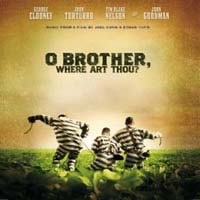
The difficulties pop/rock record producers like Burnett encounter in their attempts to construct an “acoustic” aesthetic are mirrored by artists like Dolly Parton who have spent their entire careers attempting to re-cast acoustic music in the (often outdated) image of pop/rock. The O Brother aesthetic, very consciously constructed, yet accidentally arrived at as a commercially viable template, may prove to be more of a millstone than a breakthrough, as evidenced by Burnett’s unsuccessful attempt to replicate the formula with Ralph Stanley. As the widely variant sonic character of O Brother alumni recordings demonstrate, the more lasting impact of this aesthetic may lie in the approach to process rather than processing. Instead of a wave of “acoustically” oriented, old-time Americana artists dominating the charts, I envision other musical genres adapting the sonic model of the process for commercial success—a precedent has already been set by MTV’s extremely plugged “Unplugged” series. Perhaps Madonna, Britney Spears, or Beck will embrace the solitary Neumann U47, unencumbered by other electronic wizardry for their next genre-hop. Who needs the two turntables when you’ve got the right microphone?
Works Cited
Bendix, Regina. In Search of Authenticity: The Formation of Folklore Studies. Madison: The University of Wisconsin Press, 1997.
Buskin, Richard. Inside Tracks: A First-hand History of Popular Music From the World’s Greatest Record Producers and Engineers. New York: Avon Books, 1999.
Cantwell, Robert. Ethnomimesis: Folklife and the Representation of Culture. Chapel Hill, NC: University of North Carolina Press, 1993.
Clark, Rick. “The Gospel According to Dolly Parton: Bringing Her Success Back to Her Roots.” Mix 26.9 (August 20020: 44–52.
Cunningham, Mark. Good Vibrations: A History of Record Production. London: Sanctuary Publishing Ltd., 1996.
Eisenberg, Evan. The Recording Angel: Music, Records and Culture From Aristotle to Zappa. London: Picador, 1988.
Hobsbawm, Eric. “Introduction: Inventing Tradition.” The Invention of Tradition. Eds. Eric Hobsbawm and Terrence Ranger. Cambridge: Cambridge University Press, 1983.
Jackson, Blair. “Down From the Mountain … And Into Your Town.” Mix 26.8 (July 2002): 22.
Toynbee, Jason. Making Popular Music: Musicians, Creativity and Institutions. London: Arnold, 2000.
Discography
O Brother, Where Art Thou? Mercury, 2000.
Cash, Johnny. American Recordings. American, 1994.
Chapman, Tracy. Tracy Chapman. Elektra, 1988.
Harris, Emmylou. Pieces of the Sky. Reprise, 1975.
—. Luxury Liner. Warner Bros., 1977.
—. Roses in the Snow. Warner Bros., 1980.
—. Angel Band. Warner Bros., 1987.
—. At The Ryman. Reprise, 1992.
—. Wrecking Ball. Elektra, 1995.
Hedges, Michael. Aerial Boundaries. Windham Hill, 1984.
Kottke, Leo. My Father’s Face. Private Music, 1989.
Krauss, Alison & Union Station. I’ve Got That Old Feeling. Rounder, 1991.
—. So Long So Wrong. Rounder, 1997.
—. Forget About It. Rounder, 1999.
—. New Favorite. Rounder, 2001.
Parton, Dolly. The Grass Is Blue. Sugar Hill, 1999.
—. Little Sparrow. Sugar Hill, 2001.
—. Halos and Horns. Sugar Hill, 2002.
Stanley, Ralph. Ralph Stanley. DMZ/Columbia, 2002.
Strength in Numbers, The Telluride Sessions. MCA, 1988.
Vega, Suzanne. Solitude Standing. A&M, 1987.
Welch, Gillian. Revival. Almo Sounds, 1996.
—. Hell Among the Yearlings. Almo Sounds, 1998.—. Time (The Revelator). Acony Records, 2001.
- For example, Owen Bradley’s work with Patsy Cline, along with Chet Atkins’ “countrypolitan” productions was modeled on the high-art orchestrated aspirations of Frank Sinatra’s recordings for Capitol; Billy Sherrill’s production work with Tammy Wynette was a response to the controlled chaos of Phil Spector and Motown; late 70s Nashville recordings drew inspiration from the Los Angeles based recordings of The Eagles, James Taylor, and Linda Ronstadt; and most recently, the sound of Shania Twain has dominated country radio, her hits produced by her husband, Mutt Lange, the man responsible for much of the pop-metal hits of the eighties by groups like Foreigner and Def Leppard. ↩
- For examples of this sound see The Nitty Gritty Dirt Band’s Will The Circle Be Unbroken (Capitol 63686, 1972), or any of the early New Grass Revival records. ↩
- This sound was in turn modeled on the ECM jazz records of the 1970s, right down to the album cover designs. ↩
- From Gramsci’s “subaltern,” this term is meant to describe an economically and politically powerful demographic that is nonetheless discounted and marginalized by the recording industry. Occasionally they make their presence in the marketplace known by embracing particular recordings, for example Bonnie Raitt’s Nick of Time (Capitol 91268, 1989), Eric Clapton’s Unplugged (Warner Bros., 1992), Santana’s Supernatural (Arista, 1999), and now the O Brother soundtrack. ↩
- On her album I’ve Got That Old Feeling, Krauss sang a version of a then unreleased Shawn Colvin song “I Don’t Know Why,” (which Colvin herself would have a hit with the following year) gaining a significant measure of mainstream country radio airplay. ↩
- This is clearly visible in the liner photos, a fact that subtly attempts to make a case for an “authentic” technologically mediated process. One exception—the large hall acoustics of Ryman Auditorium on “I Want To Sing That Rock And Roll,” from the Down From The Mountain film. ↩
- Tellingly, the bass player is given his own unobtrusive mic at the rear of the stage—bass being particularly difficult to isolate from other sounds in a room, and considered a crucial component in audiophile reproduction—something’s got to come out of that subwoofer in one’s recently acquired surround sound system. ↩
- http://www.neumann.com/infopool/history. Though, it is true that the U47 is still considered one of the ultimate recording microphones, a link to the traditions of Sinatra, The Beatles, George Jones, or Marvin Gaye, depending on one’s particular aesthetic allegiance. ↩
- An interesting comparison can be made between one pop old-timer resurrection and another. In 1994, Rick Rubin, known for his work with Run-DMC, the Beastie Boys, and the Red Hot Chili Peppers, released a recording of Johnny Cash, American Recordings, recorded solo, with no overdubs or reverberant treatments, largely in his living room. Rather than placing Cash, a man with decades of state-of-the-(Nashville)-art recording experience in a contemporary context, Rubin presents him as a Lomax field recording discovery, performing such “traditional classics” as Glenn Danzig’s “Thirteen.” Cash’s “man in black” persona always had an appeal to the rock crowd, and this whittled down recording aesthetic reflects trends in the rock world towards simplified recording techniques with lots of instrumental bleed and murky room tones. ↩
